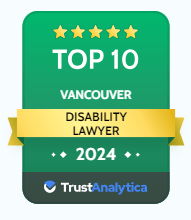Manulife Long-Term Disability: The Essential Guide
This article discusses everything you need to know about Manulife’s long-term disability benefits. This guide covers the rules and information about applying for Manulife long-term disability benefits, what happens after two years of being on Manulife long-term disability benefits as well as how to appeal a denial.
If you need to win long-term disability benefits from Manulife it is crucial to learn as much about them as you can. We wrote this guide to help you put your best foot forward when dealing with a Manulife long-term disability claim.
About Manulife
Manulife Insurance is one of Canada’s largest insurance and financial services companies. Manulife is a part of Canada’s big three disability insurance companies, along with Sun Life and Canada Life. You may have heard them go by the name of Manulife Financial or Manufacturers Life Insurance Company.
Manulife offers a range of insurance products, including short-term disability, long-term disability, illness and life insurance. It sells both individual and group disability insurance policies. It also acts as a third-party administrator for organizations that have their own disability benefits plans.
Manulife Long-Term Disability Rules
Manulife offers both group and individual long-term disability insurance policies. Generally, long-term disability refers to situations where you will be off work for 17 weeks or more.
There are no general rules for Manulife long-term disability benefits. The benefits you can receive, payment amounts, eligibility, and the procedure will depend on your insurance plan. Each insurance policy is unique, so you will need to get the correct one to learn the rules that apply to you.
For group insurance plans, your long-term disability benefits are summarized in a document called the group benefits booklet or certificate of insurance. You should always get a copy of the group benefits booklet or certificate of insurance before applying for benefits. The document should be available from your employer, union, or association.
Manulife also issues individual insurance policies. These are usually for self-employed professionals, executives, or small-business owners. You are responsible for buying this type of policy from Manulife using an insurance broker. If you have an individual insurance policy from Manulife, then the rules for your benefits can be found in the insurance policy and any amendments or riders attached to it.
Third-party administrator
There are two potential roles that Manulife might play in the payment and administration of long-term disability. They could be the insurer, administrator, and payor of benefits under a group policy. Or, they might act as the third-party administrator of benefits paid by your employer or association.
There are also situations where Manulife will be the third-party administrator of a disability plan set up and funded by a government, large employer, or other association. We refer to these types of plans as non-profit disability plans. In these cases, Manulife acts only as the administrator of the disability plan and exercises authority given to it by the organization that funds the plan. There might not be an insurance policy document as there would be if Manulife were the insurer. However, the rules for benefits are in a document called the “Plan Text” or something similar.
Regardless of Manulife’s role — insurer or third-party administrator — this will usually not change the claims process in most situations. The only time it will differ is if you need to appeal a denial of disability benefits. If Manulife is a third-party administrator, you would need to take legal action against the actual payer of benefits. This is usually your employer or association.
Similarly, if they are a third-party administrator of a non-profit disability plan, you may have restricted rights on appeals. These plans might have strict rules, procedures, and deadlines that don’t apply to regular long-term disability policies. You might not be allowed to appeal through a lawsuit but instead be limited to using the grievance and arbitration process set out in a collective agreement.
Manulife Short-Term Disability Rules
You may have Manulife’s short-term disability as part of your workplace group benefits plan. However, there is no general short-term disability plan. Short-term disability refers to situations where you are off work for a limited time, usually up to 17 weeks (but sometimes longer). Manulife offers a range of possibilities, durations, and amounts. So, the specifics of your short-term disability benefits depend on your employer and what package they selected. You need to review your workplace group benefits booklet to know the specifics of your short-term disability benefits.
You apply for Manulife short-term disability benefits by filling out forms. These include an application form, a medical report and a report from your employer. Then, Manulife reviews your application and will decide to approve or deny your claim. If your short-term disability claim gets denied, you have the right to appeal.
The rules for how you appeal will depend on your work situation. If you are in a union, your appeal may have to go through them. But this is not always the case.
Complaints Process for Manulife Insurance
The first step in resolving a problem within Manulife is to speak with your claims advisor or call a Manulife customer service representative.
After that, you can escalate your complaint to a customer service manager.
If they fail to resolve your issue, you can escalate further to the Customer Experience Care Team for an additional review. This begins a more formal investigation where the team will contact you to submit documents and information. They will provide you with written responses and information regarding your situation and their decisions.
The numbers to contact the Customer Experience Care Team are as follows:
Toll-free: 1-855-891-8671
Fax: 1-888-259-6351.
If you’re still having problems, you can contact the Ombuds Office for a secondary investigation:
Manulife, Ombuds Office
500 King Street North
Waterloo, ON N2J 4C6
Telephone: 519-747-7000 ext.248874
Toll-free: 1-877-318-4054
Fax: 519-747-6325
E-mail: ombuds.office@manulife.ca
Manulife Insurance Disability Claim Forms
If you’re a Manulife plan member, you have two options for forms. You can either go fully paper or fully digital. So, when you need to submit forms, you can print them and send them through the mail or submit them through the secure portal.
Manulife has a fairly comprehensive “Find a Form” section on its website. Some forms are accessible directly from the webpage, but it appears that the disability forms are only available if you sign in to the portal. If you’re a plan member, you should be able to easily find the forms you need through the group benefits portal.
Manulife is in the process of shifting to a fully digital experience. Although you can still submit paper forms through the mail, it’s quicker and easier to use the plan member portal or the app.
Checking your Manulife disability claim status
As stated above, Manulife plan members can only choose one: paper forms or the online portal.
Since Manulife is transitioning to provide most claims services online, the best way to stay up-to-date with your claim status is to use their online portal. The portal requires your direct deposit information and an email address when you first sign up. When you submit a claim, they will send updates to that email address.
If you opt out of using the online portal, you can check your letters or other communications from Manulife for the correct phone number to call. Usually, you can contact your case manager if you’re curious about the status of your claim.
Manulife Long-term Disability Benefits What Happens After 2 Years?
What is the importance of two years of being on long-term disability? Two years is the time when the ‘definition of disability’ changes from ‘own occupation’ to ‘any occupation.’ Also called the ‘change of definition.’ This is a common feature in most group long-term disability insurance policies in Canada, including Manulife’s.
See my article Change of Definition for Long-term Disability Benefits for a detailed review of this issue. But, the TLDR version is that for the first two years, the insurance company will pay benefits as long as you can’t do your ‘own’ occupation. However, after two years, the insurance will only pay benefits if you can’t do ‘any’ occupation. Keep in mind this doesn’t really mean any occupation. It just means any occupations you may reasonably become qualified for through training, education, or experience. The practical effect of this change is that it is much harder for you to prove there isn’t a job out there that you could do. Insurance companies know this, so they use this change of definition as an excuse to stop payments.
In fact, industry research has shown the change of definition is one of the most common times for insurance companies to stop people’s long-term disability payments.
What Happens in the Months Before the Change of Definition?
In the months and weeks leading up to the change of definition, Manulife will gather information on you. They will ask for updates from your doctor and other treatment providers. They may also ask you to participate in vocational assesments and medical testing. In some cases, you will be present for these assessments. However, other times they will do it behind the scenes without your involvement (i.e., hiring outside medical professionals to do internal medical reviews and transferable skill assessments.)
As you approach the change of definition date, Manulife will notify you if your claim will end. Sadly, Manulife and other insurance companies will wrongfully deny many disability claims after the two-year change of definition mark.
However, if Manulife denies your claim this way, don’t give up. Remember, any occupation doesn’t refer to all possible occupations. Additionally, these definitions are extremely nuanced, so a denial doesn’t necessarily mean Manulife got it right. Contact us today at jan@fishmanlawyers.ca and we can help you prove Manulife wrong.
Common Reasons For Denial After 2 Years
Manulife will never say they are cutting you off simply because you’ve been on long-term disability for two years. They need to give a legitimate — or seemingly legitamate — reason for your denial.
Some of the most common reasons for denials near the change of definition are:
- You no longer meet the definition of total disability
- Insufficient medical evidence to prove you are totally disabled from any occupation
- Lack of objective medical evidence
- Surveillance evidence that shows you are making false or misleading claims about your disability
If you have been cut off for any of these reasons, talk to a disability lawyer as soon as possible. Each reason will require specific evidence and legal strategies. As a law firm that exclusively deals with disability claims, we have tons of experience dealing with long-term disability denials after the change of definition. We know exactly what to do in these cases, and we want to help you. Call us today for a free consultation.
Appealing a Manulife Long-Term Disability Denial
You can appeal a long-term disability denial through an internal or external appeal. I’ll discuss them both in detail below.
Internal appeal
If your long-term disability claim with Manulife gets denied, the first step is to engage in an internal appeal.
You will receive a letter in the mail from Manulife stating their decision. Denial letters from Manulife are usually long and detailed. They will point out the reasons for denial or refer to specific sections of the information you provided. So, this gives you a good place to start.
We typically like getting a copy of the claim file before doing anything else. This file will detail everything that’s going on in your claim. One of the key things to look for is the reports from their independent medical reviewers. These are people who look over the information from your doctor. They determine how disabled you are and if your claim should be approved. Once you have this information, you can get it to your doctor to clarify certain things or dispute what they said.
If they are missing information, get it to them as soon as possible.
There isn’t a formal process for an internal appeal. Usually, the denial letter will set out any process or deadline you need to follow. You have to submit in writing that you want to appeal the decision. And more information will follow through letters or emails.
After one or two denials at this stage, you might want to hire a lawyer. A lawyer can help you through another internal appeal or move you forward to a legal appeal.
Legal Appeal (or lawsuit)
If you got denied after a couple of rounds of internal appeals, you might want to take it outside of Manulife. A legal appeal does exactly that. With a legal appeal, the decision-maker is someone outside of Manulife — usually a judge. This is someone from outside who has no connection to you or the insurance company. So they can make a decision objectively.
In other words, you are filing a lawsuit against Manulife. Once you file a lawsuit, Manulife assigns a lawyer and a new claim manager for this appeal. Sometimes, the new team will approve your claim simply because they have a fresh perspective.
If that doesn’t happen, you’ll get in touch with this new team to trade information. Usually, an interview will take place (with your lawyer present), so they can better understand your situation. They might approve or settle at this point. If not, they go before a judge for a final decision. However, it’s rare for a case to go that far.
Long-Term Disability Lawyers for Manulife
Some people can win long-term disability benefits with Manulife on their own, or with help from a friend or family member. However, sometimes it is hard to win on your own — even if you are legitimately disabled and should qualify. This can be very frustrating. In difficult cases, it is common for people to work with a representative. This can be a long-term disability lawyer, or another person experienced with the process. Many representatives will work on a no-win, no-fee basis. Do your research before hiring any lawyer or advocate.
Manulife Insurance Disability FAQs
The following are answers to some frequently asked questions about Manulife disability claims.
Is Manulife one of the worst disability insurance companies?
When your claim gets denied, it can feel like your insurance company is the worst in the world. In reality, it’s hard to say that one insurance company is better or worse than another. Sometimes there are legitimate grounds for Manulife to dispute your claim — even though it doesn’t feel that way. What may seem like malice is often better explained by a breakdown in systems or an overwhelmed employee. Many people are satisfied with their interactions with Manulife.
Does Manulife deny all long-term disability claims?
While we don’t have access to statistics, we can assure you that Manulife approves plenty of long-term disability claims. However, some claims aren’t so simple. There can be reasonable disagreement on whether the claim should be approved or denied. Often, this is simply due to insufficient evidence. You need to present evidence that will be convincing to Manulife to get approved.
Are Manulife disability benefits taxable as income?
Manulife disability benefits can be either taxable or non-taxable depending on the specific disability plan. It depends on the percentage of the premium paid by you and the percentage paid by your employer. Ask your employer or your Manulife claim representative.
At Fishman Lawyers, we have successfully represented people in long-term disability claims involving Manulife. Contact us at jan@fishmanlawyers.ca, for a free initial consultation.





